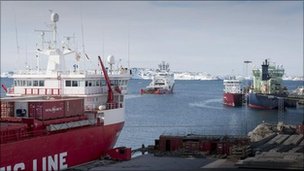
Last week, the University of Québec at Montréal hosted the two-day “Arctic in Transition: Regional Issues and Geopolitics” conference. My friend, Joël Plouffe, one of the conferences’ main organizers and an expert on geopolitics in the Arctic, let me know that it was taking place. The Centre Jacques Cartier, ArcticNet, and the Northern Research Forum (through the University of the Arctic and the University of Lapland) also helped organize the conference. Its main purpose was two analyze the dynamics of the security issues facing the Arctic. While many conferences focus on the state-based geopolitics of the North, the “Arctic in Transition” broke up Arctic into three separate regions:
These divisions are unique because they defy traditional boundaries in the Arctic, forcing us to conceive of it in a new way. Greenland is grouped with North America instead of the Nordic countries even though Denmark still technically exercises ultimate authority over the island. Russia is divided in two, with the western half grouped with the Nordic countries and the eastern half grouped with Alaska. These new regional groupings make us consider the peoples and ecosystems in the Arctic in their more natural arrangements, which sometimes cross national boundaries. For instance, the indigenous peoples of Greenland have many close ties with their counterparts in Canada, but perhaps have fewer ties with the native Saami people of the Nordic countries. The groupings probably also make more sense geographically. The western half of Russia likely has more ties and regular connections with the Nordic countries than northeastern Siberia, which is becoming more closely linked to Alaska. If the new tunnel is built in the Bering Strait between Alaska and Siberia, then this will become even more of a reality. Thus, the conference has helped to redraw the map of the Arctic.
Various round tables took place to analyze issues in the Arctic, including the development of northern Russia, the future of the maritime Arctic, and the role of Nunavik in the North American Arctic. Experts also offered new perspectives during the round table on globalization and the Arctic, illustrating the reasons why distant states like Germany and France are interested in the North.
I believe the webcast of the conference will eventually be made available, but in the meantime, you can read more about the conference and view a full itinerary here.